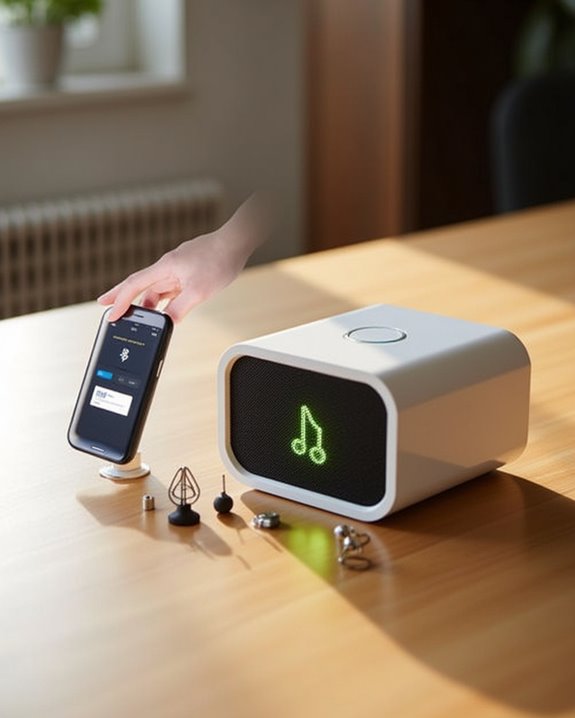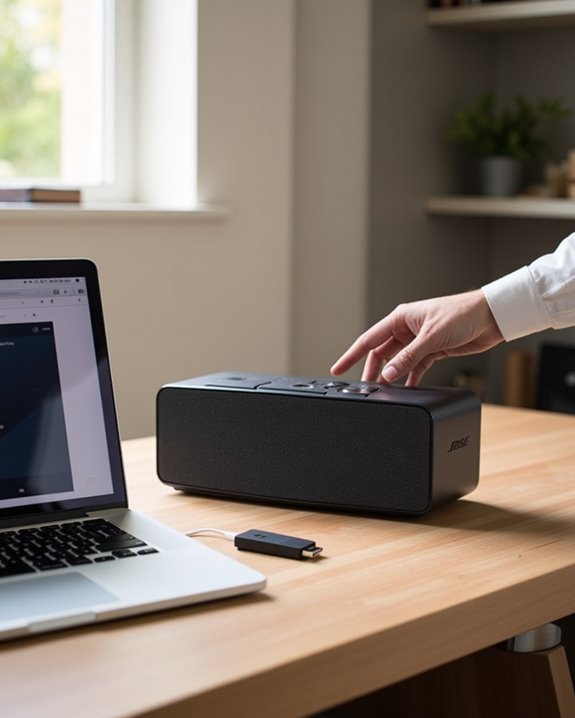The iHome Bluetooth speaker charges via a dedicated micro-USB port connected to a 5-volt USB power source or AC adapter rated at a minimum of 1 amp, ensuring stable voltage for safe, efficient recharge. Charging requires 3 to 5 hours to reach full capacity, indicated by a solid red LED turning off upon completion. Low battery is signaled by flashing red lights or audio distortion. Proper charging preserves up to eight hours playback and battery longevity. Additional insights discuss advanced charging features and maintenance.
Key Takeaways
- Connect the included micro-USB cable securely to the speaker’s micro-USB charging port and a powered USB port or 5-volt AC adapter.
- Charge the speaker for 3 to 5 hours until the LED indicator light turns off, signaling a full battery.
- A solid red LED light indicates active charging, while no light means the battery is fully charged.
- Avoid overcharging by unplugging once charging completes, preserving battery lifespan and up to eight hours of playback.
- Recharge promptly when the LED flashes red or audio distortion occurs at high volume to maintain performance.
Understanding the Charging Ports on Your Ihome Speaker
The Ihome Bluetooth Speaker is equipped with a dedicated micro-USB charging port, referred to as the USB Charging jack, which serves as the primary interface for power input and battery recharge. This USB Charging jack requires a micro-USB plug to connect the included charging cable securely, ensuring effective charging. It must be linked to a powered USB port or a USB AC adapter connected to a wall outlet to initiate the charging process. The port supports standard micro-USB cables and facilitates battery recharge within 3 to 5 hours, depending on usage. Proper attachment to the USB Charging jack is critical to avoid interruptions, as it directly interfaces with the internal battery system, making it an essential component for maintaining ideal speaker performance. Additionally, many USB speakers feature built-in batteries capable of providing up to 30 hours of playback, reducing dependence on immediate power sources.
Step-By-Step Guide to Charging Your Ihome Bluetooth Speaker
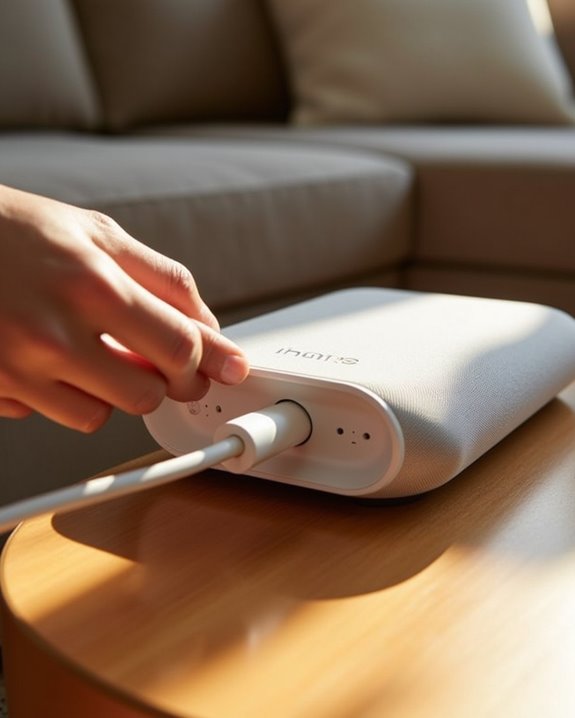
Charging an Ihome Bluetooth Speaker involves connecting its micro-USB charging port to a power source using the included cable, which features a micro-USB plug on one end and a standard USB-A connector on the other. To begin, insert the micro-USB plug into the speaker’s USB charging jack, guaranteeing a secure fit to prevent interruptions. Next, connect the USB-A end to a powered USB port or a USB AC adapter linked to a wall outlet. Upon connection, the speaker’s indicator light will illuminate solid red, confirming active charging. The battery typically requires 3 to 5 hours for a full recharge. Maintaining proper cable connection throughout guarantees consistent power delivery and preserves battery health, optimizing the speaker’s operational longevity and performance.
Recognizing Charging Indicators and Light Signals
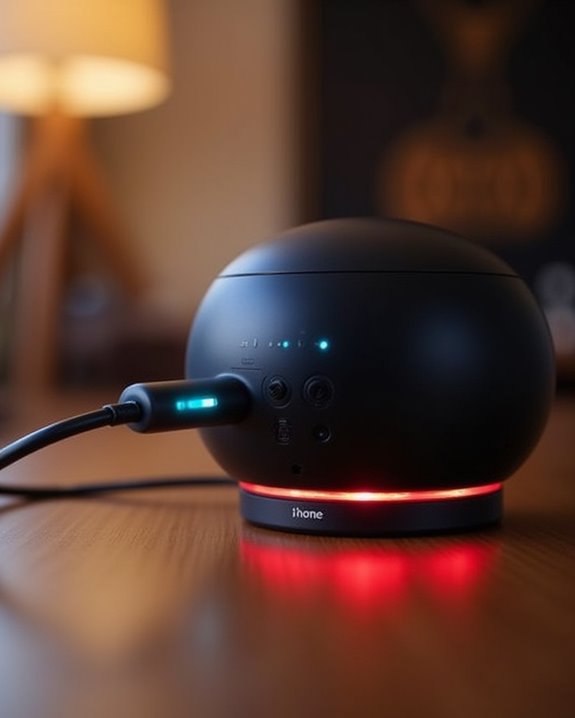
The iHome Bluetooth speaker utilizes a set of distinct LED light signals to communicate its charging status, including a solid red light during active charging and no illumination upon full battery capacity, facilitating user awareness and ideal battery management. Additional indicators such as a flashing red LED and audio distortions serve as low battery warnings, prompting timely recharging. Understanding these signals guarantees efficient device operation and prevents unexpected power loss during use.
Charging Light Meanings
Although often subtle, the indicator lights on the iHome Bluetooth Speaker provide essential feedback regarding battery status and charging progress, utilizing distinct color codes and light behaviors to convey precise information. A solid red light while charging signifies active power input, enabling users to track the process visually without auditory cues. Once the battery reaches full capacity, the red light deactivates, indicating charging completion. Conversely, the LED flashes red to warn of critically low battery levels, prompting timely recharging to prevent functional impairments such as sound distortion. Additionally, the transformation of blue light bars to red further signals the need for charging to sustain peak performance. These visual indicators collectively enhance user awareness, facilitating effective battery management and prolonging device longevity through accurate, real-time status representation.
Battery Status Signals
A critical component of the iHome Bluetooth speaker’s user interface is the LED battery status indicator, which employs specific light signals to communicate charging conditions and power levels. The LED displays a solid red light during active charging, providing users with a clear visual confirmation of power transfer. When the battery reaches full capacity, the light turns off, signaling the completion of the charging cycle. A flashing red LED warns that the battery level is critically low, prompting timely recharging to avoid service interruption. Additionally, audible cues such as sound distortion at high volumes indicate diminished battery capacity, while complete sound absence confirms full battery depletion. These battery status signals enable users to monitor power effectively, ensuring ideal device performance and longevity.
Recommended Charging Accessories and Power Sources
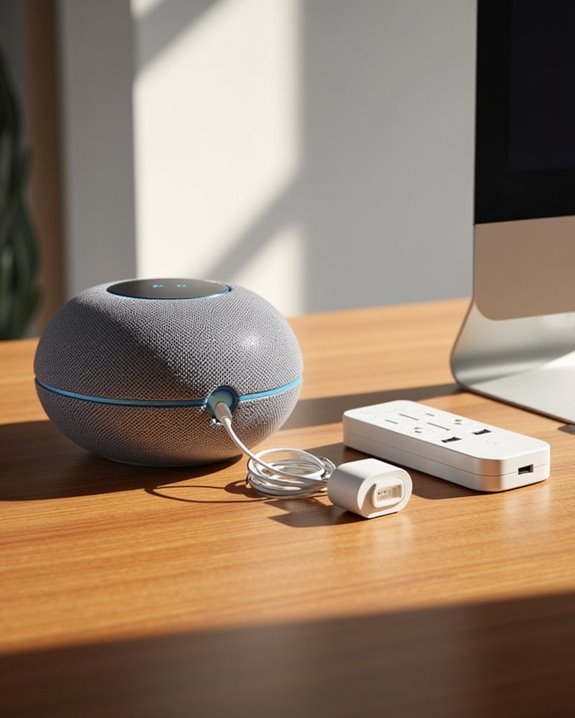
Effective charging of the iHome Bluetooth speaker depends on selecting appropriate accessories and power sources that match its technical requirements. The included micro-USB charging cable is specifically designed for ideal connection to the speaker’s USB charging jack, ensuring efficient power transfer. Connecting the cable’s larger USB plug to a powered USB port on a computer or laptop provides a stable 5-volt output suitable for charging. For enhanced performance, a USB AC adapter rated at a minimum of 1 amp is recommended, as it delivers consistent power from a standard wall outlet, reducing charge time and preventing interruptions. Users should prioritize accessories adhering to these specifications to maintain battery health and achieve reliable, safe charging outcomes for the iHome Bluetooth speaker. Additionally, choosing reliable rechargeable batteries can help maintain consistent power and extend device longevity.
How Long Does It Take to Fully Charge Your Speaker?
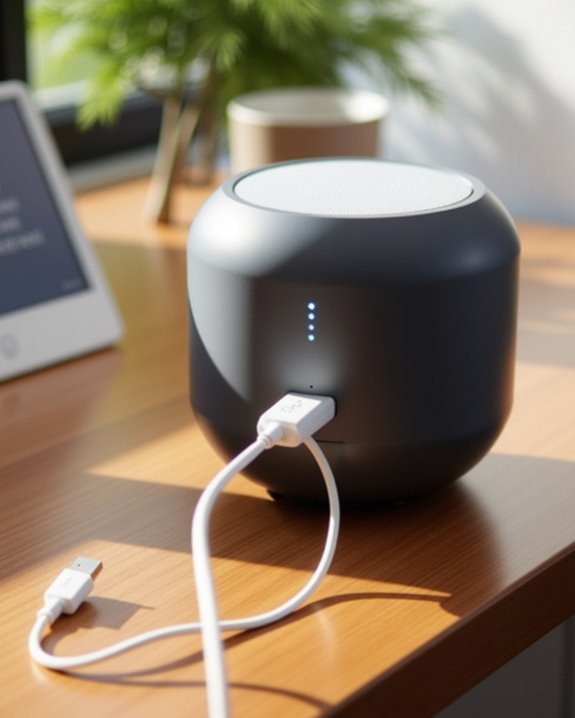
Charging duration for the iHome Bluetooth speaker is contingent upon the power source and charging accessories employed, with the included USB AC adapter providing an ideal 5-volt output at a minimum of 1 amp current. Under ideal conditions, the speaker requires approximately 3 to 5 hours of charging time to fully replenish its battery. Variations in power sources may extend the charging window to 4 to 6 hours; therefore, ensuring a stable 5V AC wall adapter is recommended for efficiency. The charging process concludes when the indicator light turns off, signifying a full charge. Secure connection of the micro-USB plug is essential to avoid interruptions. This charging time balances battery longevity and user convenience, delivering a reliable and fully charged device within a practical timeframe.
Troubleshooting Common Charging Issues
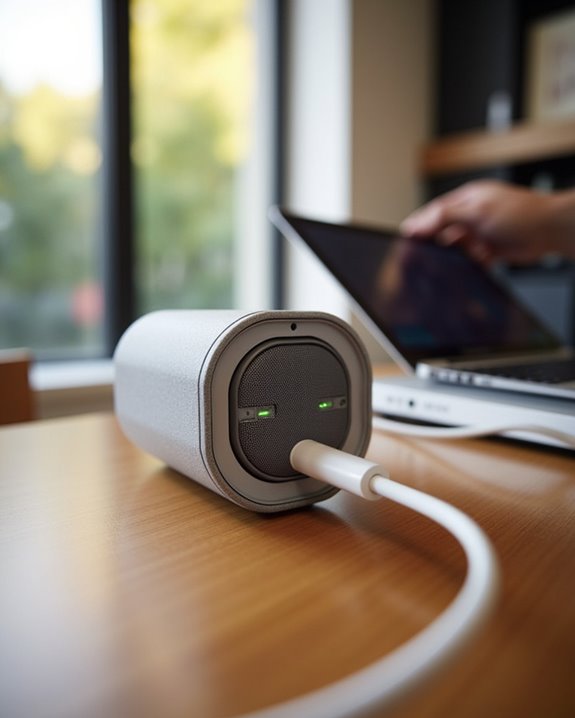
When encountering issues with the iHome Bluetooth speaker’s power replenishment, it is essential to verify the integrity of the micro-USB cable and confirm connection to a stable 5-volt AC wall adapter or a powered USB port, as improper connections frequently cause charging failures. Users experiencing a humming noise during charging should inspect the AC adapter’s wall outlet connection and consider alternative outlets to mitigate electrical interference. A flashing red LED or sound distortion at elevated volumes indicates a low battery; recharging for 3 to 5 hours until the LED is solid or off is recommended. If the speaker beeps intermittently when off, performing a reset by holding the power button for 3 seconds or unplugging the charger temporarily often resolves the issue. Note that Wireless Charging is not supported, necessitating cable-based recharging.
Tips for Maintaining Battery Health and Performance
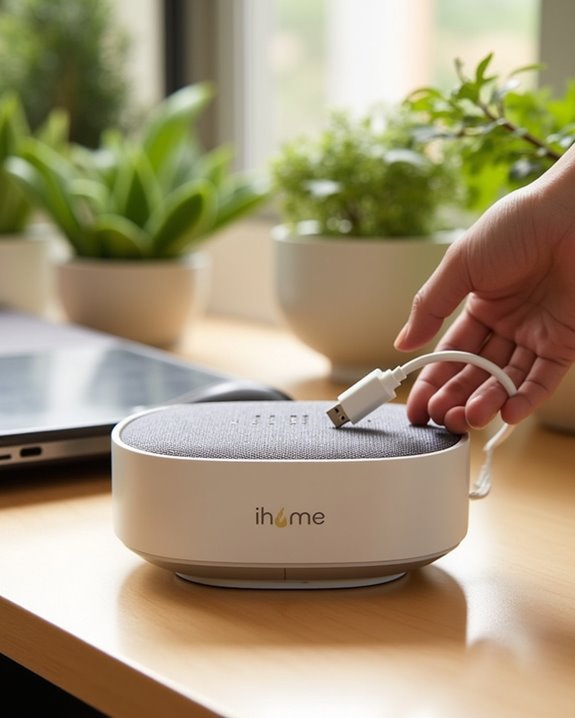
Maintaining ideal battery health in the iHome Bluetooth speaker requires adherence to specified charging durations of 3-5 hours using the original micro-USB cable connected to a stable power source, which prevents overcharging and maximizes capacity retention. Prompt recharging upon LED indication of low battery, such as a flashing red light, mitigates risks of deep discharge that can diminish overall battery lifespan and audio fidelity at elevated volumes. Proper storage conditions, including avoiding prolonged inactivity or exposure to extreme temperatures, further preserve battery performance and guarantee reliable operation over extended periods. Additionally, performing a complete charge cycle once a month helps prevent capacity degradation and maintains optimal battery performance.
Optimal Charging Practices
Although the iHome Bluetooth speaker supports a maximum playback duration of approximately eight hours per full charge, adhering to ideal charging protocols greatly enhances battery longevity and performance. To charge your device efficiently, always use the included micro-USB cable connected to a powered USB port or a 5-volt AC wall adapter, ensuring stable voltage and current supply. It is time to recharge the battery when the LED flashes red or sound distortion occurs, signaling low power. Charging for 3-5 hours until the indicator light turns off prevents overcharging, maintaining ideal battery health. Additionally, verifying secure cable connections during charging avoids power interruptions, preserving consistent energy flow and extending battery lifespan effectively for reliable speaker operation.
Avoid Overcharging Risks
Proper management of charging cycles is integral to preserving the iHome Bluetooth speaker’s battery health and ensuring consistent performance. Users should monitor the LED charging indicator, which displays a solid red light during charge and will turn off when fully charged, signaling the ideal time to unplug. Charging sessions should be limited to 3-5 hours using the included micro-USB cable connected to a 5-volt AC wall adapter, thereby preventing overcharging risks that can degrade battery capacity. Leaving the speaker plugged in after the red light turns off can cause heat buildup, reducing the battery’s effective lifespan and its standard 8-hour use duration. Adhering to these guidelines maintains battery longevity and performance, ensuring reliable operation and preserving energy efficiency over time.
Battery Storage Recommendations
When the iHome Bluetooth speaker is not in use for extended periods, storing it with a partial charge is essential to prevent battery degradation caused by deep discharge states, as indicated by the LED flashing red signal. Maintaining a charge between 40-60% preserves lithium-ion battery cells, reducing capacity loss over time. The speaker should be stored in a cool, dry environment, avoiding temperatures above 35°C or below 0°C, which adversely affect the up to 8-hour runtime. Users should recharge the battery when sound distortion occurs at high volumes, signaling low power. While the iHome speaker does not support wireless charger compatibility, charging via the included micro-USB cable for 3-5 hours guarantees ideal battery cycles. These storage practices maximize lifespan and maintain consistent audio performance.
Using Your Speaker While Charging: What You Need to Know
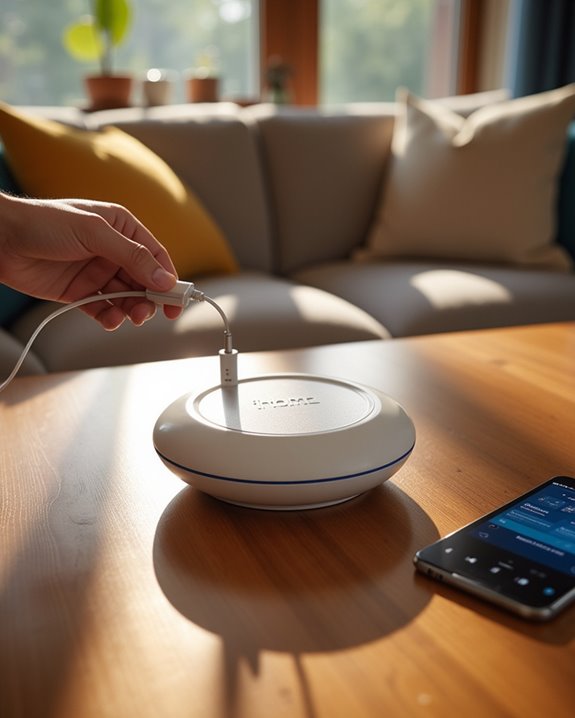
Utilizing the iHome Bluetooth speaker during charging offers uninterrupted audio playback through its integrated simultaneous charging and playback functionality, which maintains continuous operation without power interruptions. This feature enables users to enjoy music or hands-free calls within a 30-foot range while the device remains connected to a power source. However, users may notice sound distortion at higher volumes when the battery level is low during charging, signaling the need to keep the speaker plugged in until fully charged. The LED indicator flashing red serves as a reminder to continue charging for peak performance. With a full charge providing up to eight hours of battery life, using the iHome Bluetooth speaker while charging effectively preserves battery longevity during extended listening sessions.
Wireless Charging Features on Ihome Bluetooth Speakers
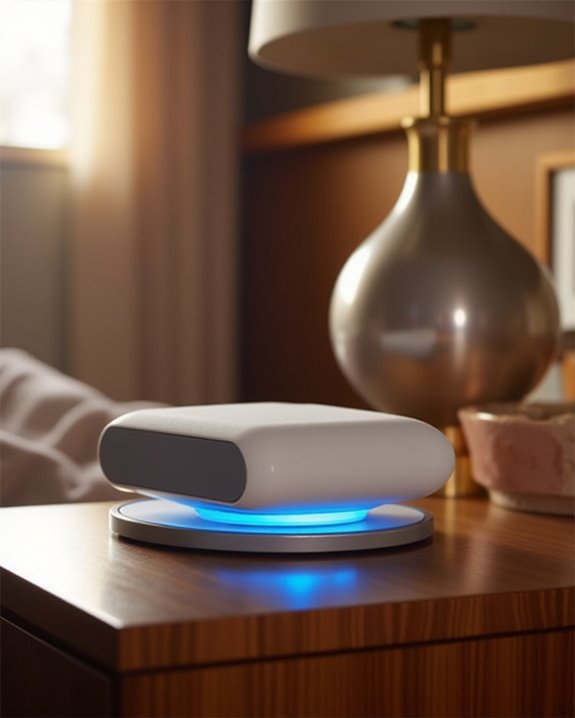
iHome Bluetooth speakers, such as the IPBT50L model, incorporate Qi wireless charging technology, enabling compatible devices to charge efficiently via a designated charging pad with MagSafe alignment for maximum stability. The charging process is monitored through a lightning icon that provides real-time status updates, including slow blinking during charging, solid illumination upon completion, and rapid blinking to indicate errors. This integration allows simultaneous audio playback and device charging, enhancing user convenience without compromising performance.
Qi Compatibility Basics
A significant advancement in portable audio devices is the integration of Qi wireless charging technology, as exemplified by models like the IPBT50L Bluetooth speaker. This speaker incorporates a Qi wireless charging pad compatible with standard Qi-enabled devices, including iPhones and Android phones, allowing cable-free power transfer. The charging pad supports MagSafe, providing magnetic alignment to optimize charging efficiency and stability. Qi-compatible devices must be positioned face up on the pad, where a blinking lightning icon confirms charging initiation. Significantly, the IPBT50L enables simultaneous audio playback and wireless charging, enhancing user convenience. This integration meets Qi standards, offering a reliable alternative to traditional wired charging. Overall, the speaker’s Qi compatibility exemplifies a modern, multifunctional design, streamlining device management for users seeking seamless connectivity and power solutions.
Charging Pad Usage
The wireless charging pad integrated into the Bluetooth speaker supports Qi standard protocols, enabling efficient inductive power transfer to compatible smartphones, including various iPhone and Android models. Users should place their devices face up and properly aligned on the pad to initiate charging, where a slow blinking lightning icon confirms active charging. The pad supports MagSafe compatibility, providing enhanced stability and ideal power delivery for iPhones. In case of misalignment or device incompatibility, a rapid blinking icon signals the need to reposition the phone. This charging pad allows simultaneous music playback and charging, making it convenient for multitasking. Upon completion, the charging indicator will turn solid BLUE, signaling a full charge and maintaining device readiness without interrupting audio functions.
Charging Indicator Lights
Charging indicator lights on the Bluetooth speaker provide critical visual feedback for the wireless charging process, utilizing a lightning icon to communicate status efficiently. A slowly blinking lightning icon on the speaker indicates active wireless charging of a Qi-compatible device, ensuring users recognize ongoing power transfer. When charging completes, the lightning icon remains solidly lit, signaling a full battery and preventing overcharge. Rapid blinking of the lightning icon alerts users to errors, such as improper device alignment or incompatibility, facilitating troubleshooting. The speaker supports MagSafe wireless charging for iPhones, enhancing secure device placement and efficiency. Monitoring the solid light on the speaker allows users to confirm ideal charging performance for Qi-enabled smartphones, promoting seamless integration of the speaker’s wireless charging capabilities within connected device ecosystems.
Differences Between Charging Ihome Models and Compatible Devices
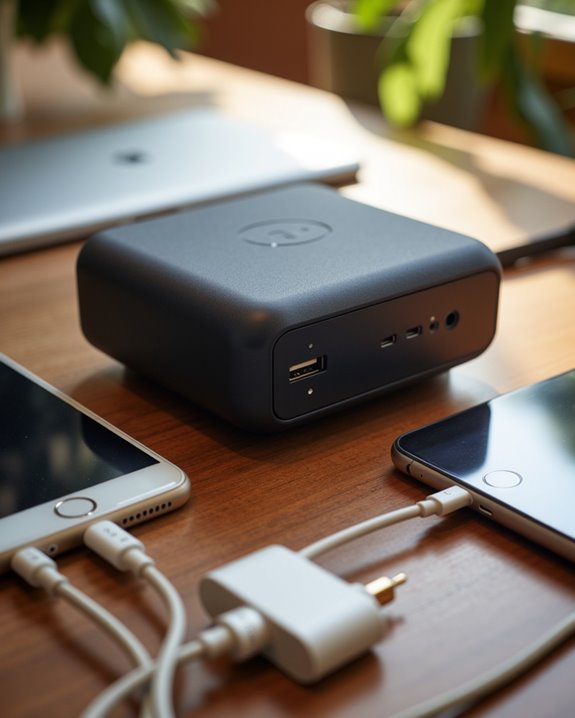
While both the iHome IPBT50L and IBT77GB models serve as portable Bluetooth speakers, their charging mechanisms exhibit notable differences in technology and user convenience. The IPBT50L supports Qi wireless charging for compatible devices, including iPhones and Android phones, via its integrated pad, enhancing hands-free operation and MagSafe compatibility for secure alignment. In contrast, the IBT77GB relies on wired charging through a micro-USB port, requiring 4-6 hours to reach full capacity, and lacks wireless capabilities. Additionally, the IPBT50L can charge multiple devices simultaneously using wireless and USB outputs, whereas the IBT77GB focuses solely on its internal battery recharge. Charging indicators differ; the IPBT50L uses solid red and lightning icons to denote charging states, while the IBT77GB employs flashing and solid red LEDs. These distinctions impact user experience and compatibility within the iHome BT speaker lineup.
Frequently Asked Questions
What Type of Charger Does an Ihome Speaker Use?
The iHome speaker requires charger types including a micro-USB cable paired with adapter options like a 5 Volt USB AC wall adapter. These standard choices guarantee reliable charging and connect users to familiar, compatible power sources.
Can I Charge My Bluetooth Speaker With a USB Cord?
Charging a Bluetooth speaker with a USB cord is effective when using compatible power adapters to guarantee USB safety. Proper connection to powered sources fosters a sense of reliability and belonging within the device’s user community.
How Do I Know if My Speaker Is Charging?
The charging light serves as a clear battery indicator, glowing solid red or blue during charging. Observing this light assures users their speaker is replenishing power, fostering confidence and connection among those relying on seamless audio experiences.
How Can I Charge My Bluetooth Speaker Without a Charger?
Like capturing sunlight in a bottle, solar charging and hand cranking offer alternative energy sources for Bluetooth speakers. These communal methods empower users to stay connected, embracing eco-friendly and self-reliant ways to keep tunes alive.


